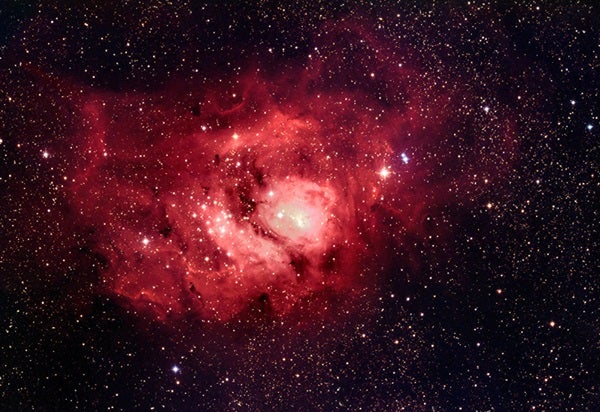Astronomers are currently using ESO’s VISTA to scour the Milky Way’s central regions for variable objects and map its structure in greater detail than ever before. This huge survey is called VISTA Variables in the Via Lactea (VVV). The new infrared image presented here was taken as part of this survey. It shows the stellar nursery called the Lagoon Nebula (M8) that lies about 4,000 to 5,000 light-years away in the constellation Sagittarius the Archer.
Infrared observations allow astronomers to peer behind the veil of dust that prevents them from seeing celestial objects in visible light. This is because visible light, which has a wavelength that is about the same size as the dust particles, is strongly scattered, but the longer wavelength infrared light can pass through the dust largely unscathed. VISTA, with its 4.1-meter-diameter mirror — the largest survey telescope in the world — is dedicated to surveying large areas of the sky at near-infrared wavelengths deeply and quickly. It is ideally suited to study star birth.
Stars typically form in large molecular clouds of gas and dust, which collapse under their own weight. The Lagoon Nebula, however, is also home to a number of more compact regions of collapsing gas and dust, called Bok globules. These dark clouds are so dense that, even in the infrared, they can block the starlight from background stars. But the most famous dark feature in the nebula, for which it is named, is the lagoon-shaped dust lane that winds its way through the glowing cloud of gas.
Hot young stars, which give off intense ultraviolet light, are responsible for making the nebula glow brightly. But the Lagoon Nebula is also home to much younger stellar infants. Newborn stars have been detected in the nebula that are so young that they are still surrounded by their natal accretion disks. Such newborn stars occasionally eject jets of matter from their poles. When this ejected material ploughs into the surrounding gas, short-lived bright streaks called Herbig-Haro objects are formed, making the newborns easy to spot. In the past 5 years, several Herbig-Haro objects have been detected in the Lagoon Nebula, so the baby boom is clearly still in progress here.
Astronomers are currently using ESO’s VISTA to scour the Milky Way’s central regions for variable objects and map its structure in greater detail than ever before. This huge survey is called VISTA Variables in the Via Lactea (VVV). The new infrared image presented here was taken as part of this survey. It shows the stellar nursery called the Lagoon Nebula (M8) that lies about 4,000 to 5,000 light-years away in the constellation Sagittarius the Archer.
Infrared observations allow astronomers to peer behind the veil of dust that prevents them from seeing celestial objects in visible light. This is because visible light, which has a wavelength that is about the same size as the dust particles, is strongly scattered, but the longer wavelength infrared light can pass through the dust largely unscathed. VISTA, with its 4.1-meter-diameter mirror — the largest survey telescope in the world — is dedicated to surveying large areas of the sky at near-infrared wavelengths deeply and quickly. It is ideally suited to study star birth.
Stars typically form in large molecular clouds of gas and dust, which collapse under their own weight. The Lagoon Nebula, however, is also home to a number of more compact regions of collapsing gas and dust, called Bok globules. These dark clouds are so dense that, even in the infrared, they can block the starlight from background stars. But the most famous dark feature in the nebula, for which it is named, is the lagoon-shaped dust lane that winds its way through the glowing cloud of gas.
Hot young stars, which give off intense ultraviolet light, are responsible for making the nebula glow brightly. But the Lagoon Nebula is also home to much younger stellar infants. Newborn stars have been detected in the nebula that are so young that they are still surrounded by their natal accretion disks. Such newborn stars occasionally eject jets of matter from their poles. When this ejected material ploughs into the surrounding gas, short-lived bright streaks called Herbig-Haro objects are formed, making the newborns easy to spot. In the past 5 years, several Herbig-Haro objects have been detected in the Lagoon Nebula, so the baby boom is clearly still in progress here.










